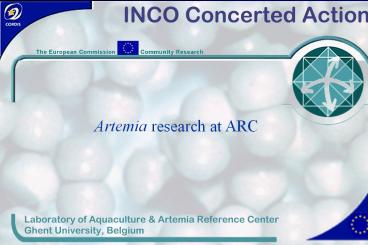Artemia research at ARC - PowerPoint PPT Presentation
Title:
Artemia research at ARC
Description:
Artemia research at ARC ARC traditionals : description of strain characteristics biometrics hatching & diapause characteristics lifespan & reproductive ... – PowerPoint PPT presentation
Number of Views:189
Avg rating:3.0/5.0
Title: Artemia research at ARC
1
Artemia research at ARC
2
- ARC traditionals description of strain
characteristics - biometrics
- hatching diapause characteristics
- lifespan reproductive characteristics
- effect of abiotic conditions on growth,
reproduction. - cross-breeding
- HUFA content
- ..
- cooperation with other partners !
3
2. Artemia population assessment studies
cfr. fluctuations in Great Salt Lake harvests
- abiotic conditions
- primary production
- Artemia population
4
Russian Federation (Siberia)
Karabogaz-Gol, Turkmenistan
China (Tibet)
5
3. Mass-rearing and biocontrol potential of
predatory insects (Heteroptera, Coleoptera)
(Cooperation with Laboratory of Agrozoology,
RUG)
Orius
Harmonia
Podisus
6
Cost-effective production of killer bugs
production of large numbers at low price
Use of Lepidopteran eggs, esp. of Mediterranean
flour moth, Ephestia kuhniella
- good development reproduction of
- predatory insects
- high price
- (high investment production costs,
- high demand, occasional market shortages)
- possible human health problems (allergene)
nymph IV Orius
7
Promising preliminary results Artemia cysts as
alternative to Ephestia eggs effect on growth,
metamorphosis, survival, reproduction of
predator application techniques (decapsulated
vs. non-decapsulated, hydration level)
8
- 4. Proposal for a new VIB (Flemish Institute of
Biotechnology) - Department
- Department of Microbial Ecology of Aquatic
Invertebrates - Ghent University, Belgium
- Laboratory of Microbial Ecology and Technology
- Laboratory of Aquaculture Artemia Reference
Center - University of Connecticut, USA
- Dalhousie University, Canada
9
- Rationale
- Eukaryotes exist in close association with
micro-organisms symbiotic, pathogenic, neutral - EMCs (eukaryote microbial communities)
- Colonisation of EMCs by allochthonous organisms
- 1st step in development of pathogenesis,
commensalism, symbiosis. - Objective
- How do allochthonous micro-organisms establish
themselves in the EMCs ? What factors - determine success or failure ?
- new insights into host-pathogen and
host-probiotic interactions - therapeutic and probiotic opportunities.
- Model eukaryote Artemia franciscana
- Model allochthonous organisms Vibrionaceae
- pathogenic or beneficial to Artemia
- culture collection available extensive
database available of chromosomal mobile
genetic elements important to Vibrio
success in EMCs - common pathogens of almost all higher
eukaryotes, - develop a comprehensive model of Vibrionaceae
invasion and colonisation
10
Host-Microbe Unit
11
Microbe-Microbe Unit
12
Mobile Genetic Element Unit
13
5. FWO project the functional role and
characteristics of micro-organisms in the
larviculture of aquatic organisms with Artemia as
a test species
- Rationale
- general trend towards more natural suppression
of opportunistic/obligate - pathogens in aquaculture
- consensus about critical role of microbial
interactions - numerous questions about biological processes
involved - competition for adhesion sites in digestive
tract - competition for nutrients
- excretion of antibacterial products by
bacteria/micro-algae - stimulation of immune system by
algae/yeasts/bacteria - test organisms not cultured axenically
interactions with micro-organisms
14
Objective Study the mode of action of microbial
organisms verify hypotheses by use of
axenically cultured organism
partners Laboratory of Aquaculture Artemia
Reference Center (RUG) Prof. Godelieve Criel
(RUG) Laboratory for Microbial Ecology
(RUG) Laboratory for Aquatic Ecology
Aquaculture (KULeuven)
15
research questions 1. How do bacteria colonize
the gut??
16
research questions 1. How do bacteria colonize
the gut? 2. How does a pathogen infect an
aquatic organism?
through the gills?
ingestion?
through the cuticula?
17
research questions 1. How do bacteria colonize
the gut? 2. How does a pathogen infect an
aquatic organism? 3. How does a probiotic
protect an aquatic organism?
18
First action develop an axenic standard culture
of Artemia
autoclaved
seawater
culture vessels
decapsulated
cysts
?-irradiated
food
19
Further actions
- Linked to the axenic cultures and using
scanning-electron microscopy, an atlas of a
normal gut of successive developmental stages
would be compiled. - At a later stage, the colonization of the gut
- by selected harmless and pathogenic
- bacteria will be studied quantitatively and
- qualitatively using diverse microbial
- marker techniques (FiSH, DGE, GFP).
- Besides, we will consider axenic
- Dunaliella cultures as food source in order
- to investigate the possible probiotic
- role of algae.
Laboratory of Aquaculture Artemia Reference
Center, Ghent University, Belgium































